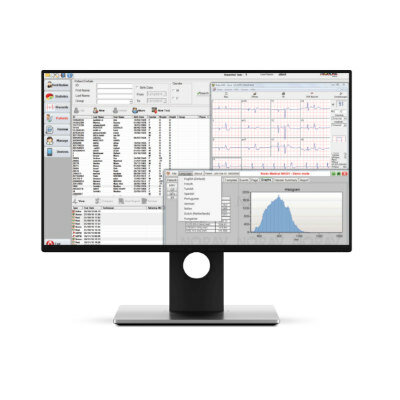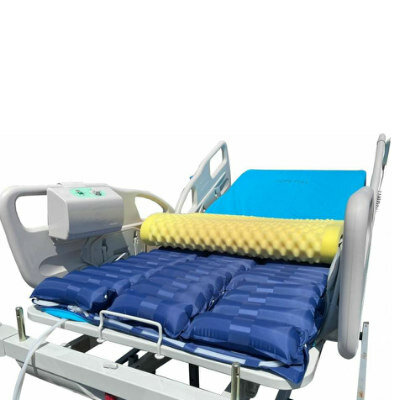Telemedicine Patient Management Increases Life Expectancy
|
By HospiMedica International staff writers Posted on 10 Sep 2018 |

Image: New research suggests that telemedicine can increase heart failure patient’s longevity (Photo courtesy of Alamy).
Telemedical interventional management reduces hospitalizations and prolongs the life of patients with heart failure (HF), according to a new study.
Researchers at Charité University Medicine (Charité; Berlin, Germany), University Hospital Würzburg (Germany), and other institutions throughout Germany conducted a prospective, controlled, randomized study to investigate the efficacy of a telemedical interventional management program in 1,538 patients with a left ventricular ejection fraction (LVEF) of 45% or lower. Half of the patients received a remote management intervention in addition to usual care; the other half received usual care only. The primary outcome was unplanned cardiovascular hospital admissions or all-cause death.
Patients in the remote management group received an electrocardiogram (ECG) monitoring unit with finger clip to measure oxygen saturation; a blood pressure monitor; scales to measure body weight; and a tablet computer to record self-reported health status data. Using the tablet computer, all patient data were transferred automatically to Charité's Telemedical Centre, where a team of doctors and nurses was available to continuously review the transmitted data and initiated specific measures, such as changing the patient's medication, recommending an outpatient visit, or inpatient treatment.
The results revealed that patients in the telemedical intervention group lost significantly fewer days due to unplanned hospitalizations for cardiovascular reasons than patients in the control group (17.8 versus 24.2 days, respectively). All-cause mortality for patients assigned to remote patient management was also significantly lower; over the course of a year, the death rate among patients in the usual care group was approximately 11.3 per 100 person-years, compared to 7.8 per 100 person-years in the telemedical group. The study was published on August 25, 2018, in The Lancet.
“The trial was able to show that the use of telemedicine can increase life expectancy; this finding applied irrespective of whether patients lived in rural areas with inadequate health care infrastructure, or in metropolitan areas,” said senior author Professor Friedrich Koehler, MD, of Charité. “This means that, in addition to improving the overall quality of health care provision, telemedicine is suitable for use as a compensatory strategy to offset regional differences in health care provision between rural and urban areas.”
Telemedicine is essentially a product of 20th century telecommunication and information technologies that permit communications between patient and medical staff with both convenience and fidelity, as well as the transmission of medical, imaging, and health informatics data from one site to another. It is most often used to improve patient, doctor, and nursing staff access to medical services in distant or sparsely populated rural communities.
Related Links:
Charité University Medicine
University Hospital Würzburg
Researchers at Charité University Medicine (Charité; Berlin, Germany), University Hospital Würzburg (Germany), and other institutions throughout Germany conducted a prospective, controlled, randomized study to investigate the efficacy of a telemedical interventional management program in 1,538 patients with a left ventricular ejection fraction (LVEF) of 45% or lower. Half of the patients received a remote management intervention in addition to usual care; the other half received usual care only. The primary outcome was unplanned cardiovascular hospital admissions or all-cause death.
Patients in the remote management group received an electrocardiogram (ECG) monitoring unit with finger clip to measure oxygen saturation; a blood pressure monitor; scales to measure body weight; and a tablet computer to record self-reported health status data. Using the tablet computer, all patient data were transferred automatically to Charité's Telemedical Centre, where a team of doctors and nurses was available to continuously review the transmitted data and initiated specific measures, such as changing the patient's medication, recommending an outpatient visit, or inpatient treatment.
The results revealed that patients in the telemedical intervention group lost significantly fewer days due to unplanned hospitalizations for cardiovascular reasons than patients in the control group (17.8 versus 24.2 days, respectively). All-cause mortality for patients assigned to remote patient management was also significantly lower; over the course of a year, the death rate among patients in the usual care group was approximately 11.3 per 100 person-years, compared to 7.8 per 100 person-years in the telemedical group. The study was published on August 25, 2018, in The Lancet.
“The trial was able to show that the use of telemedicine can increase life expectancy; this finding applied irrespective of whether patients lived in rural areas with inadequate health care infrastructure, or in metropolitan areas,” said senior author Professor Friedrich Koehler, MD, of Charité. “This means that, in addition to improving the overall quality of health care provision, telemedicine is suitable for use as a compensatory strategy to offset regional differences in health care provision between rural and urban areas.”
Telemedicine is essentially a product of 20th century telecommunication and information technologies that permit communications between patient and medical staff with both convenience and fidelity, as well as the transmission of medical, imaging, and health informatics data from one site to another. It is most often used to improve patient, doctor, and nursing staff access to medical services in distant or sparsely populated rural communities.
Related Links:
Charité University Medicine
University Hospital Würzburg
Latest Health IT News
- Machine Learning Model Improves Mortality Risk Prediction for Cardiac Surgery Patients
- Strategic Collaboration to Develop and Integrate Generative AI into Healthcare
- AI-Enabled Operating Rooms Solution Helps Hospitals Maximize Utilization and Unlock Capacity
- AI Predicts Pancreatic Cancer Three Years before Diagnosis from Patients’ Medical Records
- First Fully Autonomous Generative AI Personalized Medical Authorizations System Reduces Care Delay
- Electronic Health Records May Be Key to Improving Patient Care, Study Finds
- AI Trained for Specific Vocal Biomarkers Could Accurately Predict Coronary Artery Disease
- First-Ever AI Test for Early Diagnosis of Alzheimer’s to Be Expanded to Diagnosis of Parkinson’s Disease
- New Self-Learning AI-Based Algorithm Reads Electrocardiograms to Spot Unseen Signs of Heart Failure
- Autonomous Robot Performs COVID-19 Nasal Swab Tests

- Statistical Tool Predicts COVID-19 Peaks Worldwide
- Wireless-Controlled Soft Neural Implant Stimulates Brain Cells
- Tiny Polymer Stent Could Treat Pediatric Urethral Strictures
- Human Torso Simulator Helps Design Brace Innovations
- 3D Bioprinting Rebuilds the Human Heart
- Nanodrone Detects Toxic Gases in Hazardous Environments
Channels
Artificial Intelligence
view channel
AI-Powered Algorithm to Revolutionize Detection of Atrial Fibrillation
Atrial fibrillation (AFib), a condition characterized by an irregular and often rapid heart rate, is linked to increased risks of stroke and heart failure. This is because the irregular heartbeat in AFib... Read more
AI Diagnostic Tool Accurately Detects Valvular Disorders Often Missed by Doctors
Doctors generally use stethoscopes to listen for the characteristic lub-dub sounds made by heart valves opening and closing. They also listen for less prominent sounds that indicate problems with these valves.... Read moreCritical Care
view channel
Deep-Learning Model Predicts Arrhythmia 30 Minutes before Onset
Atrial fibrillation, the most common type of cardiac arrhythmia worldwide, affected approximately 59 million people in 2019. Characterized by an irregular and often rapid heart rate, atrial fibrillation... Read more
Breakthrough Technology Combines Detection and Treatment of Nerve-Related Disorders in Single Procedure
The peripheral nervous system (PNS) serves as the communication network that links the brain and spinal cord to every other part of the body. It consists of two parts: the somatic nervous system, which... Read moreSurgical Techniques
view channel
Hydrogel-Based Miniaturized Electric Generators to Power Biomedical Devices
The development of engineered devices that can harvest and convert the mechanical motion of the human body into electricity is essential for powering bioelectronic devices. This mechanoelectrical energy... Read moreWearable Technology Monitors and Analyzes Surgeons' Posture during Long Surgical Procedures
The physical strain associated with the static postures maintained by neurosurgeons during long operations can lead to fatigue and musculoskeletal problems. An objective assessment of surgical ergonomics... Read more.jpg)
Custom 3D-Printed Orthopedic Implants Transform Joint Replacement Surgery
The evolving field of 3D printing is revolutionizing orthopedics, especially for individuals requiring joint replacement surgeries where traditional implants fail to provide a solution. Although most people... Read more
Cutting-Edge Imaging Platform Detects Residual Breast Cancer Missed During Lumpectomy Surgery
Breast cancer is becoming increasingly common, with statistics indicating that 1 in 8 women will develop the disease in their lifetime. Lumpectomy remains the predominant surgical intervention for treating... Read morePatient Care
view channel
Surgical Capacity Optimization Solution Helps Hospitals Boost OR Utilization
An innovative solution has the capability to transform surgical capacity utilization by targeting the root cause of surgical block time inefficiencies. Fujitsu Limited’s (Tokyo, Japan) Surgical Capacity... Read more
Game-Changing Innovation in Surgical Instrument Sterilization Significantly Improves OR Throughput
A groundbreaking innovation enables hospitals to significantly improve instrument processing time and throughput in operating rooms (ORs) and sterile processing departments. Turbett Surgical, Inc.... Read more
Next Gen ICU Bed to Help Address Complex Critical Care Needs
As the critical care environment becomes increasingly demanding and complex due to evolving hospital needs, there is a pressing requirement for innovations that can facilitate patient recovery.... Read moreGroundbreaking AI-Powered UV-C Disinfection Technology Redefines Infection Control Landscape
Healthcare-associated infection (HCAI) is a widespread complication in healthcare management, posing a significant health risk due to its potential to increase patient morbidity and mortality, prolong... Read morePoint of Care
view channel
Critical Bleeding Management System to Help Hospitals Further Standardize Viscoelastic Testing
Surgical procedures are often accompanied by significant blood loss and the subsequent high likelihood of the need for allogeneic blood transfusions. These transfusions, while critical, are linked to various... Read more
Point of Care HIV Test Enables Early Infection Diagnosis for Infants
Early diagnosis and initiation of treatment are crucial for the survival of infants infected with HIV (human immunodeficiency virus). Without treatment, approximately 50% of infants who acquire HIV during... Read more
Whole Blood Rapid Test Aids Assessment of Concussion at Patient's Bedside
In the United States annually, approximately five million individuals seek emergency department care for traumatic brain injuries (TBIs), yet over half of those suspecting a concussion may never get it checked.... Read more
New Generation Glucose Hospital Meter System Ensures Accurate, Interference-Free and Safe Use
A new generation glucose hospital meter system now comes with several features that make hospital glucose testing easier and more secure while continuing to offer accuracy, freedom from interference, and... Read moreBusiness
view channel
Johnson & Johnson Acquires Cardiovascular Medical Device Company Shockwave Medical
Johnson & Johnson (New Brunswick, N.J., USA) and Shockwave Medical (Santa Clara, CA, USA) have entered into a definitive agreement under which Johnson & Johnson will acquire all of Shockwave’s... Read more
















